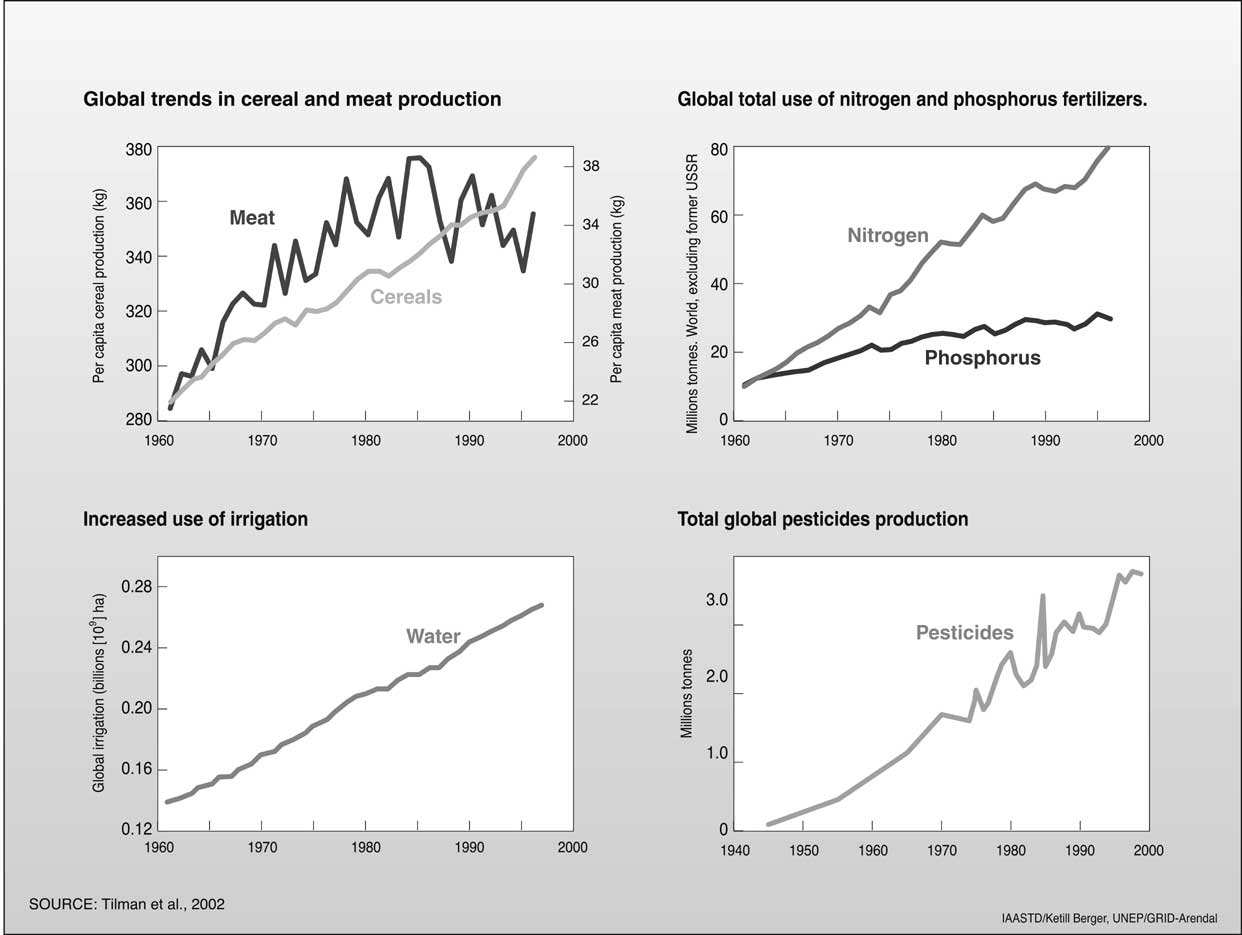
| Previous | Return to table of contents | Search Reports | Next |
| « Back to weltagrarbericht.de | ||
Impacts of AKST on Development and Sustainability Goals | 149

Figure 3-1. Global trends in cereal and meat production; nitrogen and phosphorus fertilizer use; irrigation, and pesticide production.
|
doubled in absolute terms since the 1960s (Figure 3-2). In contrast, in developing countries in Africa the average cereal yields have increased at a rate of 10 kg ha-1 yr-1 and productivity levels are about one-half of those achieved in industrialized countries in the early 1960s. In sub-Saharan Africa (SSA) approximately 66% of the crop production increase since 1961 is linked to area expansion. These broader trends mask significant differences among the grain staples. For example, in industrialized countries, maize productivity has grown at average rate of 122 kg ha-1 yr-1, increasing from a base of 3 tonnes ha-1 in 1961 to nearly 8 tonnes ha-1 in 2005. In 1961, maize productivity was approximately 1 tonne ha-1 in developing countries. Since then, maize yields have steadily increased in developing regions of Asia (72 kg ha-1 yr-1), demonstrated intermediate growth in Central America (37 kg ha-1 yr-1), but achieved only slow growth among developing countries in Africa (12 kg ha-1 yr-1). A major reason for this, especially in Africa, has been the lack of investment in public and private sector plant breeding programs (Morris, 2002). Similar trends are evident in rice and for other major commodities such as vegetables, roots, pulses and tubers (Figure 3-2). Recently horticulture, including fruit production, has been the fastest growing food sector worldwide
Horticulture production has increased from 495 million tonnes in 1970 to 1379 million tonnes in 2004 (178%) (FAOSTAT, 2007). The vegetable subsector grew at an an- |
nual average rate of 3.6% during 1970-2004 from 255 million tonnes in 1970 to 876 million tonnes in 2004 (Ali, 2006). Most of this increased production came from area expansion with productivity per unit area increasing at less than 1% from 1970-2004. The slow improvement in the yield of horticulture crops suggests comparatively low investments in horticultural research. During 1970-2004, 52% of the increase in horticulture production came from China, 40% from all other developing countries, and remaining 8% from developed countries (Ali, 2006). This increase is having significant positive effects on income, employment, micronutrient availability and health of people in poor countries. Moreover, the share of horticulture products in trade, especially from developing countries, has increased (Ali, 2006). Global production and consumption of livestock products have been growing dramatically over the last few decades.
From 1979 to 2003, global meat production nearly doubled to 260 million tonnes (FAOSTAT, 2007). Among developing countries, those with large populations and rapidly growing economies (e.g., China, Brazil and India) accounted for over 50% of meat and milk production in 2005. Consumption of livestock products has also increased sharply, in part due to rising incomes and increasing urbanization in several parts of the developing world. Between 1962 and 2003 per capita meat consumption grew by a factor of 2.9, and milk by 1.7 in developing countries (Steinfeld et al., 2006; FAO, 2006a). |
|||||||||||
| Previous | Return to table of contents | Search Reports | Next |
| « Back to weltagrarbericht.de | ||